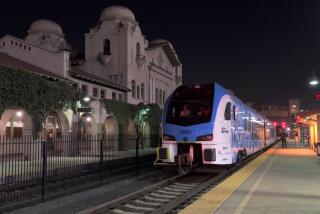Time, Cost of Electrifying Rail System Are Debated : Transportation: Edison says the commuter line could be in operation within two years. But officials who favor diesel trains call that study too optimistic.
Ventura County transportation officials and Southern California Edison are at odds over a proposal to power commuter trains traveling though the San Fernando Valley with electricity, quarreling over how long it would take to build such a system and even on whether diesel trains would do more harm than good to air quality.
Edison has suggested that the proposed commuter rail line linking Ventura, San Bernardino and Los Angeles counties be electrified. A Ventura official said this week that such a plan would delay commencement of service for seven to 10 years, although the utility said electrification might be accomplished in two years.
Moreover, electrification of the 130-mile network would add millions of dollars to its cost, said Ginger Gherardi, executive director of the Ventura County Transportation Commission.
The line is scheduled to be operational by November, 1992, using diesel locomotives.
“It doesn’t make sense” to wait for electrification of the route, Gherardi said. “It seems to me that the most important thing right now is to get people out of their cars and into trains, instead of waiting 10 years.”
According to a study commissioned by Edison, delivered to the California Transportation Commission last week, the diesels actually would create more pollution than all of the vehicles the trains are projected to replace, an assertion Gherardi disputes.
The Edison study concluded that, compared to cars, the commuter trains would emit 90% less of one class of smog components, reactive organic gases. But the diesel locomotives would double the amount of another pollutant, oxides of nitrogen, the study said.
Gherardi said she is not convinced.
“Their position is somewhat distorted,” she said. “The fact is that the trains will cut pollutants in half.”
Ventura County Supervisor Vicky Howard, a member of the county transportation commission, said she has not seen the Edison study but also is skeptical of its conclusions.
“I’m surprised,” Howard said. “I think we would almost have to do another study to make sure it’s accurate . . . and not self-serving.”
“It’s pretty obvious,” Gherardi said, why Edison would want the rail system to be electrified--it would be the line’s main supplier of power.
But Richard Schweinberger, manager of electric transportation research at Edison, said the company believes that its study is accurate. “The benefits of electric trains are cleaner air and more energy efficiency,” Schweinberger said.
Edison plans to discuss the study’s findings in detail with the Los Angeles County Transportation Commission and other government officials on Aug. 20, Schweinberger said.
The L.A. Transportation Commission has been working with transit agencies in Ventura, San Bernardino, Orange and Riverside counties to put together a commuter rail network that will link the five counties.
Plans already have been approved for the first three segments to begin service in November of next year. Trains will run between Union Station in downtown Los Angeles through the San Fernando Valley to Moorpark in Ventura County and to the Santa Clarita Valley, as well as San Bernardino.
Schweinberger said Edison is “willing to explore the possibility” of sharing the cost of electrifying the 130-mile line linking the three counties. Once Edison got the go-ahead from the state Public Utilities Commission, it would take at least 24 months to electrify the rail system, he said.
But Gherardi said that estimate is “hopelessly optimistic.” She said it would take “seven to 10 years, at least.”
Electric locomotives would cost about $5 million each and take about five years to manufacture, compared to $1 million to $2 million for each of the 17 diesels that already are being built for the commuter line, Gherardi and the LACTC officials said. The locomotives are expected to be delivered early next year.
The best solution, Gherardi and Howard said, would be to get the commuter trains running as soon as possible and electrify the system later.
“I don’t think we should delay any of this,” Howard said. “The sooner we start getting cars off the road, the better off we’re going to be.”
Gherardi agreed. “I think all of us want the cleanest form of transportation possible, but I also think that something has to be done about the traffic problem as soon as possible,” Gherardi said.
“I think it’s a little late to be coming in here at the eleventh hour with a new plan when there is already a well-conceived plan to get service started by next year,” she said.
More to Read
Sign up for Essential California
The most important California stories and recommendations in your inbox every morning.
You may occasionally receive promotional content from the Los Angeles Times.









